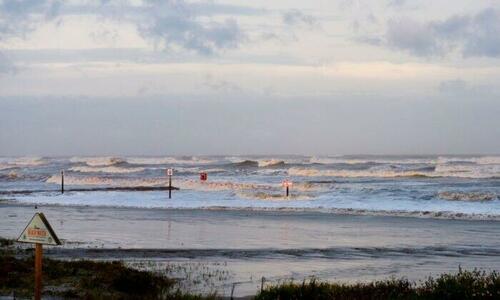No Tropical Storms Or Hurricanes Have Developed In The Atlantic For 3 Weeks
Authored by T.J.Muscaro via The Epoch Times,
It’s been more than three weeks since a named tropical storm or hurricane has developed in the Atlantic, according to the National Hurricane Center (NHC) as of Sept. 5.
While five low pressure disturbances have been spotted in the Atlantic, Caribbean, and Gulf of Mexico, there is little chance that this streak will come to an end in the next few days.
Hurricane Ernesto earned its name on Aug. 12, and the NHC issued its last advisory about the storm on Aug. 20, which, by that day, was moving over the north Atlantic more than 400 miles east-northeast of Newfoundland, Canada.
This marks a three-week gap between tropical cyclones reaching a level of strength and organized convection that warrants a name, and two weeks since a tropical cyclone advisory was issued.
Each of the five low pressure disturbances have a small possibility of becoming a tropical storm within the next week.
“Overall, the tropics (Atlantic basin) are starting to awaken from the slumber we have had for the last few weeks,” Stan Goldenberg, a meteorologist for the Hurricane Research Division at NOAA’s Atlantic Oceanographic & Meteorological Laboratory, told The Epoch Times in an email.
He added that there could be several factors as to why they are not seeing more development now, such as the current state of a usually storm-producing phenomenon called the Madden-Julian Oscillation, and enduring dryness in the air.
“We are still seeing a lot of dry air inhibiting activity, but that normally starts to clear out about this time so it is expected to change soon,” he said.
Possible Storm Developments
Only two disturbances appear to be having an immediate impact on land. Disturbance 1 is currently affecting the northwest Gulf Coast around Texas and Louisiana with a 10 percent chance of further development in the next seven days.
“Although development is unlikely, heavy rainfall is expected across portions of the northern Gulf Coast during the next day or so,” the NHC stated.
Meanwhile, Disturbance 4 was expected to reach Belize and the Yucatan Peninsula by Aug. 6, and is described as disorganized shower and thunderstorm activity.
The most probable disturbance to develop was spotted in the northwest Atlantic ocean between North Carolina and Bermuda. The NHC labeled this storm L99 and gave it a 30 percent chance of developing in the next 48 hours, reporting better-organized showers and thunderstorms and near-gale force winds (39 to 54 mph).
“This system could acquire some tropical or subtropical characteristics over the next day or two while it moves generally north-northeastward, remaining offshore of the northeastern United States,” the NHC stated. “Once the low moves over cooler waters by early Saturday, further development is not expected.”
The potential for storm development is also tracked by the NOAA Climate Prediction Center’s Global Tropical Hazards Outlook, which is updated every Tuesday. But that, too, appears to suggest that the relative calm will continue.
Dan Harnos, a meteorologist for NOAA’s Climate Prediction Center, told The Epoch Times in an email that the outlook suggests a greater than 40 percent chance that a hurricane will develop between Sept. 11 and 17 in the Atlantic and the Gulf of Mexico, “with lower probabilities of formation across the tropical Atlantic the following week.
“Also on the horizon is the potential forecast shift to La Niña conditions forecast during September-October-November, which have been shown to lengthen the duration of prior Atlantic hurricane seasons.”
Named Storms
Tropical Storms and Hurricanes in the Atlantic—which includes the Caribbean and Gulf of Mexico—are given names in alphabetical order throughout the season. This means that as of Sept. 5, only five named storms were recorded and only three of those five reached hurricane status. This included Hurricane Beryl, which became the earliest-forming Category 5 hurricane on record.
For comparison, in 2023, the National Hurricane Center (NHC) reported seven named storms within the two-week period between Aug. 20 and Sept. 5: Tropical Storm Gert, Tropical Storm Emily, Hurricane Franklin, Tropical Storm Harold, Hurricane Idalia, Tropical Storm Jose, and Tropical Storm Katia.
Tropical Storms Gert, Emily, Jose, and Katia never made landfall.
“I do think it’s surprising for the tropics to be relatively quiet as we approach the historical peak of the season, which is just a few days away,” Erica Grow Cei, a National Weather Service spokesperson and meteorologist, told The Epoch Times in an email.
“But that’s just statistics! The atmospheric conditions mentioned by Dr. Harnos are preventing any of the waves originating off the coast of Africa from developing further. So meteorologically, it makes sense.”
The Atlantic hurricane season runs from June 1 through Nov. 30, and NOAA has said there’s a 90 percent chance that 2024 will have higher than normal activity and a 10 percent chance that activity will be near normal.
NOAA predicted the 2024 season will have 17 to 24 named storms (winds of 39 mph or higher), with eight to 13 of them being hurricanes (winds of 74 mph or higher) and four to seven being major hurricanes, in its Aug. 4 report. A major hurricane is one that grows to a Category 3 or stronger with wind speeds of 111 mph or greater.
NOAA states that a typical Atlantic hurricane season produces 14 named storms, seven of which are hurricanes and three of which are major hurricanes.
To those living in hurricane-prone areas, Grow Cei said it only takes one tropical storm or hurricane to cause a catastrophe, and that the 2024 season is far from over.
“Enjoy this respite from a normally active period for the tropics, but make sure your supplies are ready in the event a new storm starts brewing,” she said.
Tyler Durden
Fri, 09/06/2024 – 13:25
via ZeroHedge News https://ift.tt/aiwcDmJ Tyler Durden
